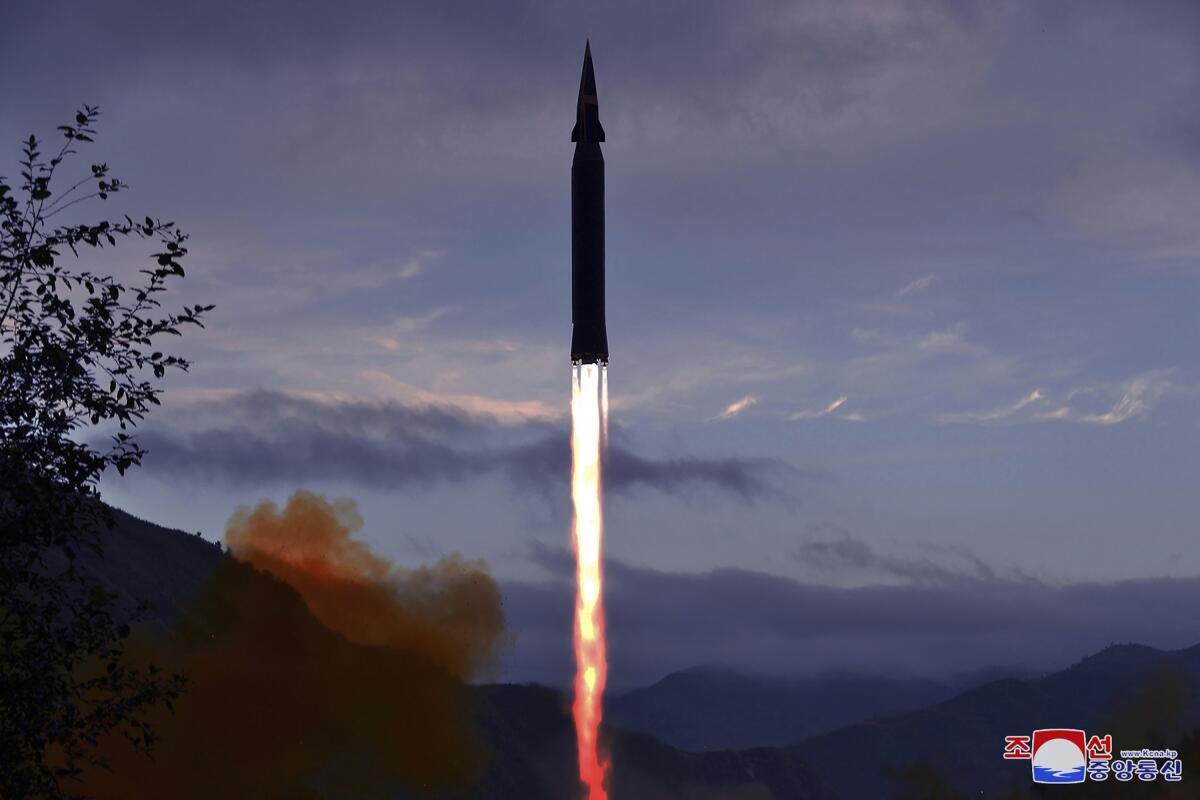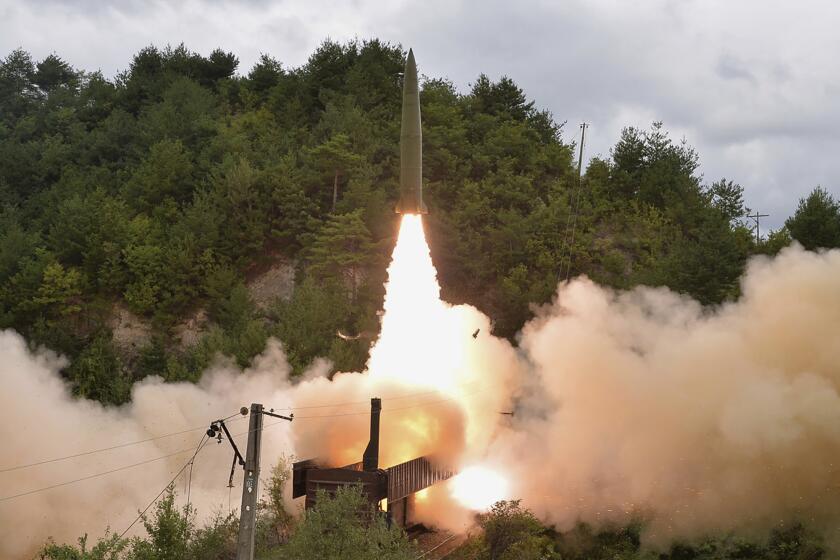North Korea says it successfully tested a new hypersonic missile

- Share via
SEOUL — North Korea said Wednesday it successfully tested a new hypersonic missile that it implied was being developed as nuclear-capable, as Pyongyang continues to expand its military capabilities to pressure the U.S. and South Korea over long-stalled negotiations on its nuclear weapons.
The missile test early Tuesday was North Korea’s third round of launches this month and took place shortly before North Korea’s United Nations envoy accused the United States of hostility. The envoy demanded that the Biden administration permanently end joint military exercises with South Korea and the deployment of strategic assets in the region.
A photo published in North Korea’s state media showed a missile mounted with a finned, cone-shaped payload soaring into the air, trailing bright orange flames. Pyongyang’s official Korean Central News Agency said the missile met key technical requirements during its first flight test, including launch stability and the maneuverability and flight characteristics of the “detached hypersonic gliding warhead.”
South Korea’s Joint Chiefs of Staff assessed the missile to be at an early stage of development and said North Korea would need “considerable time” to be able to deploy it operationally.
The North’s announcement came a day after the South Korean and Japanese militaries said they detected North Korea firing a missile into its eastern sea. The U.S. Indo-Pacific Command said the launch highlighted “the destabilizing impact of [North Korea’s] illicit weapons program.”
In a separate report, KCNA said the rubber-stamp parliament opened a session Tuesday and discussed domestic issues such as economic policies and youth education. Some experts speculate that North Korea might use the session to address the deadlock on nuclear diplomacy, but the state media report did not mention any comments made toward Washington and Seoul.
Analysts say the ratcheting up of military might between North and South Korea raises the possibility of misunderstandings that could spiral to dangerous consequences.
At a meeting of the ruling party in January, North Korean leader Kim Jong Un named hypersonic glide vehicles, which are launched from a rocket before gliding into a target, on a wish list of sophisticated military assets. KCNA described the new missile as an important addition to the country’s “strategic” weaponry, implying that the system is being developed to deliver nuclear weapons.
The report also said the test confirmed the stability of the missile’s fuel capsule, indicating a technology to add liquid propellant beforehand and keep it launch-ready for years. A North Korean official said the North planned to expand the system to all its liquid-fuel missiles.
Liquid-fuel missiles are more vulnerable than solid-fuel missiles because they need to be fueled separately and transported to launch sites using trucks that can be seen by enemy satellites or other military assets.
Kim Dong-yub, a professor at the University of North Korean Studies in Seoul, said North Korea is trying to improve the mobility of these weapons.
Recent satellite images show North Korea is expanding a uranium enrichment plant at its main Yongbyon nuclear complex.
North Korea last week made offers to improve relations with South Korea under certain conditions, apparently returning to its pattern of mixing weapons demonstrations with peace overtures to wrest concessions.
Negotiations over its nuclear program have been in a stalemate since February 2019. North Korea has demanded the lifting of U.S.-led sanctions while insisting that it has the right to nuclear weapons. U.S. officials have made it clear that the sanctions will stay in place until Pyongyang takes concrete steps toward denuclearization.
In recent political speeches, Kim has vowed to bolster his nuclear program as a deterrent to the U.S. His government has so far rejected the Biden administration’s offer to resume talks without preconditions, saying that Washington must abandon its “hostile policy” first, a term North Korea mainly uses to refer to sanctions and joint U.S.-South Korea military drills, which the North considers to be an invasion rehearsal.
Kim’s influential sister reached out to Seoul twice last week, saying her country was open to resuming talks and conciliatory steps if conditions are met.
Start your day right
Sign up for Essential California for the L.A. Times biggest news, features and recommendations in your inbox six days a week.
You may occasionally receive promotional content from the Los Angeles Times.
Analysts say North Korea is using the South’s desire for engagement to pressure Seoul to extract concessions from Washington on Kim’s behalf.
North Korea’s weapons displays could also be aimed at shoring up domestic unity as Kim faces perhaps his toughest moment in almost a decade of rule, with pandemic border closures unleashing further shock on an economy battered by sanctions and decades of mismanagement.
Experts say North Korea will probably continue its weapons-testing activity in the coming months as it dials up its pressure campaign, at least until China begins pushing for calm ahead of the Winter Olympics in Beijing early next year.
More to Read
Sign up for Essential California
The most important California stories and recommendations in your inbox every morning.
You may occasionally receive promotional content from the Los Angeles Times.















